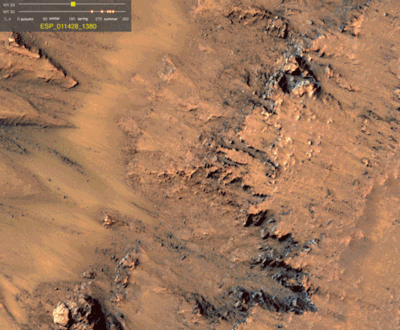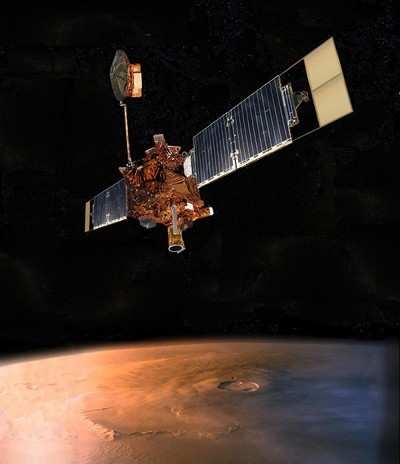Images From MRO Show Seasonal Changes Over Several Years
Observations from NASA's Mars Reconnaissance Orbiter (MRO) have
revealed possible flowing water during the warmest months on Mars.
"NASA's Mars Exploration Program keeps bringing us closer to
determining whether the Red Planet could harbor life in some form,"
NASA Administrator Charles Bolden said, "and it reaffirms Mars as
an important future destination for human exploration."
NASA MRO Image

Dark, finger-like features appear and extend down some Martian
slopes during late spring through summer, fade in winter, and
return during the next spring. Repeated observations have tracked
the seasonal changes in these recurring features on several steep
slopes in the middle latitudes of Mars' southern hemisphere.
"The best explanation for these observations so far is the flow
of briny water," said Alfred McEwen of the University of Arizona,
Tucson. McEwen is the principal investigator for the orbiter's High
Resolution Imaging Science Experiment (HiRISE) and lead author of a
report about the recurring flows published in Thursday's edition of
the journal Science.
Some aspects of the observations still puzzle researchers, but
flows of liquid brine fit the features' characteristics better than
alternate hypotheses. Saltiness lowers the freezing temperature of
water. Sites with active flows get warm enough, even in the shallow
subsurface, to sustain liquid water that is about as salty as
Earth's oceans, while pure water would freeze at the observed
temperatures. "These dark lineations are different from other types
of features on Martian slopes," said MRO project scientist Richard
Zurek of NASA's Jet Propulsion Laboratory in Pasadena, Calif.
"Repeated observations show they extend even farther downhill with
time during the warm season."
The features imaged are only about 0.5 to 5 yards or meters
wide, with lengths up to hundreds of yards. The width is much
narrower than previously reported gullies on Martian slopes.
However, some of those locations display more than 1,000 individual
flows. Also, while gullies are abundant on cold, pole-facing
slopes, these dark flows are on warmer, equator-facing slopes. The
images show flows lengthen and darken on rocky equator-facing
slopes from late spring to early fall. The seasonality, latitude
distribution and brightness changes suggest a volatile material is
involved, but there is no direct detection of one. The settings are
too warm for carbon-dioxide frost and, at some sites, too cold for
pure water. This suggests the action of brines which have lower
freezing points. Salt deposits over much of Mars indicate brines
were abundant in Mars' past. These recent observations suggest
brines still may form near the surface today in limited times and
places.

When researchers checked flow-marked slopes with the orbiter's
Compact Reconnaissance Imaging Spectrometer for Mars (CRISM), no
sign of water appeared. The features may quickly dry on the surface
or could be shallow subsurface flows. "The flows are not dark
because of being wet," McEwen said. "They are dark for some other
reason."
A flow initiated by briny water could rearrange grains or change
surface roughness in a way that darkens the appearance. How the
features brighten again when temperatures drop is harder to
explain. "It's a mystery now, but I think it's a solvable mystery
with further observations and laboratory experiments," McEwen
said.
These results are the closest scientists have come to finding
evidence of liquid water on the planet's surface today. Frozen
water, however has been detected near the surface in many middle to
high-latitude regions. Fresh-looking gullies suggest slope
movements in geologically recent times, perhaps aided by water.
Purported droplets of brine also appeared on struts of the Phoenix
Mars Lander. If further study of the recurring dark flows supports
evidence of brines, these could be the first known Martian
locations with liquid water.
 Airborne 04.16.24: RV Update, Affordable Flying Expo, Diamond Lil
Airborne 04.16.24: RV Update, Affordable Flying Expo, Diamond Lil ANN's Daily Aero-Term (04.20.24): Light Gun
ANN's Daily Aero-Term (04.20.24): Light Gun Aero-News: Quote of the Day (04.20.24)
Aero-News: Quote of the Day (04.20.24) Aero-News: Quote of the Day (04.21.24)
Aero-News: Quote of the Day (04.21.24) ANN's Daily Aero-Term (04.21.24): Aircraft Conflict
ANN's Daily Aero-Term (04.21.24): Aircraft Conflict




